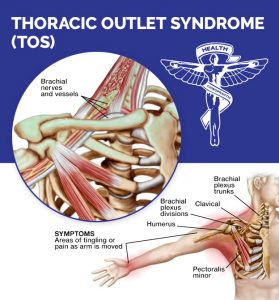Thoracic outlet syndrome
Thoracic outlet and cervicobrachial syndrome are painful

conditions that result from the compression of blood vessels and or nerves. These travel through three anatomical regions where compression may occur. First is a muscular region between the anterior scalene muscle and the middle scalene muscle. The second narrowing can take place in a skeletal region from the top rib, clavicle (collarbone) and top of the scapula and a third region is in a sub pec minor space, which lies beneath the coracoid process of the scapula, the pec minor tendon, and the ribs 2-4. The neurological cause of pain accounts for 95 to 99% of all cases.
Symptoms and signs of Thoracic outlet syndrome can vary between patients and can cause a range of symptoms from mild pain to upper limb complications.
The most common presentation is on the neck, base of the skull, face shoulder, chest, and the patient will map a path of pain down the inside of his or her arm to the ring and little finger. Ranging from a dull ache to sharp pain. When the upper plexus is involved, (nerve roots C5-6-7) headaches may be a common symptom.
Other common symptoms
- Weakness in the arm and or hand is quick to fatigue.
- Tingling, numbness, and pins and needles from the shoulder to the hand can be felt.
- Swelling may occur in the arm and hand.
- The patient may experience a changed or absent sensation.
- The skin may be discoloured or blotchy.
- A difference in temperature may occur, such as intense heat or coldness. These symptoms are usually associated with vascular TOS.
Symptoms are exacerbated when the arm is raised overhead and rotated externally, while the head is rotated to either side.
Congenital origins for TOS:
- Muscle anomalies
- Cervical rib
- Altered scalene muscle insertions
- New bone growth of the first rib
- Scoliosis of the cervico-thoracic spine
- Muscular bands becoming fibrous
- Prolonged transverse process of C7
Muscular origins:
- Decreased tone of the levator scapulae, trapezius, and rhomboid muscles
- Trapezius, scalene levator scapulae, and pectoral muscles become shortened
- Overdeveloped scalene muscle
Acquired origins:
- Poor work posture
- Rib fracture
- Fractured clavicle
- Repetitive strain injuries (most common cause is prolonged slouching at a keyboard)
- Hyperextension injuries of the neck, such as whiplash
- Trauma
- Drooping shoulders
- Poor posture
- Incorrect work posture, (too much time sitting or standing, without addressing the curve of one’s spine)
Can Chiropractic help with TOS?
A professional chiropractor will take a history and perform a series of tests to diagnose if the condition is thoracic outlet syndrome. A management program will be determined. Treatment may include chiropractic joint mobilisation and adjustments to the cervical and thoracic spine, first rib, elbow, wrist, and hand joints, trigger point therapy of involved muscles, postural corrections, stretching, and exercise programmes.
Dr. Cassimatis (chiropractor) is a qualified professional that may help with thoracic outlet syndrome. If you have any questions please call cairns chiropractic for a consultation.
